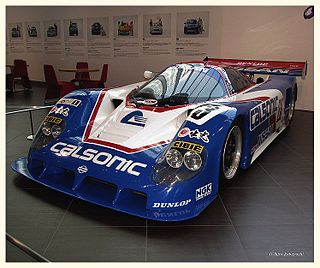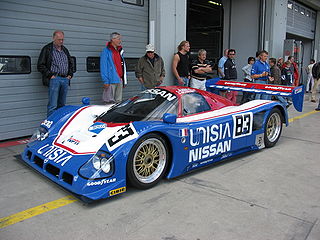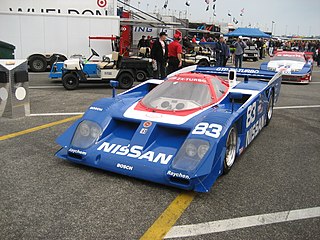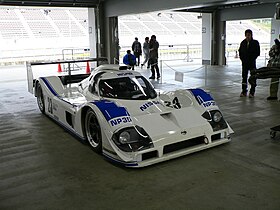
Nissan Motorsports International, abbreviated as Nismo, is a division of Nissan Motorsports & Customizing focused in motorsport and performance-oriented car models for Nissan. Nismo was initially a company, Nissan Motorsports International Co., Ltd., formed in 1984 as a result of a merger of two motorsport departments, being the in-house tuning, motorsports and performance subsidiary of Nissan. It has competed in JSPC, JTCC, the 24 Hours of Le Mans and the 24 Hours of Daytona. They currently participate in Super GT, GT Racing and Formula E. Nismo ceased to be a company in April 2022 by being merged with sister Autech into a new Nissan subsidiary, Nissan Motorsport & Customizing.

The Mazda 787 and its derivative 787B are Group C sports prototype racing cars that were developed by Japanese automobile manufacturer Mazda for use in the World Sportscar Championship, All Japan Sports Prototype Championship, and the 24 Hours of Le Mans from 1990 to 1991. Designed to combine a mixture of the Fédération Internationale du Sport Automobile (FISA) Group C regulations with the International Motor Sports Association (IMSA) GTP regulations, the 787s were the last Wankel rotary-powered racing cars to compete in the World and Japanese championships, using Mazda's R26B engine.

The Porsche 962 is a sports-prototype racing car built by Porsche as a replacement for the 956 and designed mainly to comply with IMSA's GTP regulations, although it would later compete in the European Group C formula as the 956 had. The 962 was introduced at the end of 1984, from which it quickly became successful through private owners while having a remarkably long-lived career, with some examples still proving competitive into the mid-1990s. The vehicle was later replaced by the Porsche WSC-95.

The Jaguar XJR-9 is a sports-prototype race car built by Jaguar for both FIA Group C and IMSA Camel GTP racing, debuting at the 1988 24 Hours of Daytona.
Dome Co. Ltd, literally "child's dream", is a Japanese racing car constructor involved mainly in open-wheel and sports car racing.

The Nissan R89C was a Group C sports prototype developed by Nissan.

The Mazda MXR-01 is a Group C sports prototype that was used by Mazda's factory team Mazdaspeed in the 1992 World Sportscar Championship season. It would be the final Mazda entry in sports car racing since the inception of its Le Mans project in 1983. It was based on the Jaguar XJR-14.

The Nissan R391 is a prototype racing car built by Nissan and their motorsports counterpart Nismo for competition at the 1999 24 Hours of Le Mans. It was a replacement for the R390 GT1, which was no longer legal in its production-based class.

The Nissan R90C was a platform used for Group C racing cars built in 1990 by Nissan Motors for competition in World Sportscar Championship (WSC) based in Europe and the All Japan Sports Prototype Championship (JSPC). The cars based on the basic R90C platform would compete until 1993 before Nissan chose to withdraw from sports car racing, not returning until 1997. It won three JSPC championships and several significant endurance races during its career.

The Nissan GTP ZX-Turbo was a series of racing cars developed for Nissan Motors by Electramotive Engineering to compete in the IMSA GT Championship. Running from 1985 to 1990, they were known for being the first car to defeat the Porsche 962 which had dominated IMSA's premiere GTP category. This led to Nissan winning the constructor's championship and 12 Hours of Sebring in 1989 and 1990. During 1990, the GTP ZX-Turbo was replaced by the newer NPT-90.

The Nissan NPT-90 was a racing car developed in 1990 for Nissan Motors by Nissan Performance Technology Incorporated (NPTI), formerly known as Electramotive Engineering. It was a replacement for the highly successful GTP ZX-Turbo that had won the IMSA GT Championship in 1989. The NPT-90 would go on to win the championship in 1990 and 1991 before being retired by Nissan at the end of the 1992 season.

The Mazda RX-792P is a sports prototype racing car built for the IMSA GT Championship's GTP category for Mazda. Its career was short lived, with only two cars running in 1992 before the project was abandoned.

The VRT35 is 3.5L V12 piston engine from Nissan. It was developed for competition racing during the early 1990s by Nissan's motorsport division Nismo.

The Eagle MkIII is a sports prototype racing car built by All American Racers in 1991 to IMSA GTP specifications. Powered by a turbocharged Toyota inline-4 engine, the car was campaigned in the IMSA Camel GT series by Dan Gurney's Toyota-sponsored AAR team from 1991 through to the end of 1993. The Eagle MkIII won 21 out of the 27 races in which it was entered and is considered one of the most successful and technologically advanced designs of the IMSA GTP era — "a car that proved so overwhelmingly dominant that the class for which it was created has now been assigned to history", according to Racer magazine.

The Ligier JS P2 is a racing car designed and built by French manufacturer Onroak Automotive and named in partnership with French former racing driver Guy Ligier. Designed for the Le Mans Prototype 2 (LMP2) regulations, it is intended as a second option to Onroak's Morgan LMP2 that has been competing since 2012. As well as being the first closed-cockpit car offered by Onroak, it is also the first car they designed entirely in-house. The JS P2 debuted at the 2014 24 Hours of Le Mans, and has been campaigned in the FIA World Endurance Championship, European Le Mans Series, Asian Le Mans Series and IMSA WeatherTech SportsCar Championship.

The Nissan GT-R LM Nismo is a sports prototype racing car built by the Nissan Motor Company and their motorsports division Nismo. Designed for the Le Mans Prototype 1 (LMP1) regulations of the FIA World Endurance Championship and the 24 Hours of Le Mans, the GT-R LM was unique amongst Le Mans Prototypes at the time for utilizing a front mid-engine layout for its internal combustion engine, as opposed to the rear mid-engine layout used by nearly all other competitors in the category. It was Nissan's first prototype chassis since the R391 in 1999, although the company had developed engines in recent years. The car was branded after the Nissan GT-R road car and shares similar engine and drivetrain configurations, but is not related to the sports car. The GT-R LM Nismo program was announced on 23 May 2014, while the car was publicly shown for the first time in a Nissan commercial during Super Bowl XLIX on 1 February 2015. It was retired from competition at the end of 2015, after having only competed unsuccessfully at the 2015 24 Hours of Le Mans.

The March 86G was a Group C and IMSA GTP sports racing car built by March Engineering. Built as simply a chassis with no engine, it was branded as one of three cars, the BMW GTP, the Buick Hawk or the Nissan R86V depending on which engine was placed in the chassis and which team was running it. There were a number of subtle bodywork changes to reflect the manufacturer which ran the car.

The Ligier JS P217 is a Le Mans Prototype built by Onroak Automotive and named in a partnership with French racing driver Guy Ligier. The Ligier JS P217 was built to meet the 2017 FIA and ACO regulations for 2017 for the LMP2 category in the FIA World Endurance Championship. The car also meets the regulations for the International Motor Sports Association’s (IMSA) WeatherTech SportsCar Championship for the Prototype class. It was active in both of these championship series as well as the European Le Mans Series and Asian Le Mans Series. The prototype made its racing debut at the 2017 24 Hours of Daytona and its FIA World Endurance Championship debut at the 2017 6 Hours of Spa-Francorchamps.

The Ligier Nissan DPi, also known as the Onroak Nissan DPi is a Daytona Prototype car built by Ligier Automotive. The car is based on the Ligier JS P217, which was built to meet the 2017 FIA and ACO regulations for 2017 for the LMP2 category in the FIA World Endurance Championship. The prototype made its racing debut at the 2017 24 Hours of Daytona, with the Tequila Patrón ESM team, finishing 4th on its debut.

The March 85G was a mid-engined IMSA racing sports prototype, designed and developed by March Engineering in 1984 and used in sports car racing until 1988.





















